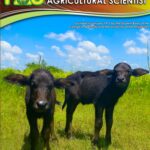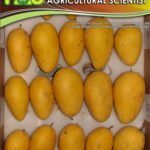Vol. 105, No. 4 (https://doi.org/10.62550/RI1210504)
Huanglongbing (HLB) caused by Candidatus Liberibacter asiaticus and tristeza caused by Citrus tristeza virus (CTV) are the major diseases affecting citrus species including calamansi (Citrofortunella microcarpa Bunge) in the country. Oriental Mindoro, aptly called the “Calamansi King” of the Philippines, produces more than 97%, contributing to 33% of the country’s total calamansi production (PSA 2017). Disease surveillance found that HLB and tristeza are prevalent in the province, and they occur mostly in mixed infection with symptoms of blotchy mottle and interveinal chlorosis on the leaves.
{Photograph courtesy of Dr. Filomena C. Sta. Cruz, Institute of Weed Science, Entomology and Plant Pathology, College of Agriculture and Food Science, University of the Philippines Los Banos)
Categories
Articles
Synthesis and Characterization of Nanozeolite from Sugarcane Bagasse Ash and Its Nutrient Loading Potential
Quincy E. Ybañez, Pearl B. Sanchez, Marcial S. Buladaco II, and Joy Eloiza M. Rosales
Sugarcane bagasse, a known agricultural waste product in the Philippines with 88% silica (SiO2) content based on elemental analysis, is a viable starting material for zeolite synthesis. In this study, silica derived from sugarcane bagasse ash (SBA) collected from La Carlota, Negros Occidental, Philippines, was extracted via an alkaline extraction method using 2M NaOH and precipitation with 5 N H2SO4 under constant stirring at elevated temperature. Sodium aluminate was added as aluminum source then subjected to ageing at 80°C for 72 h to form the clinoptilolite-type zeolite crystals. Characterization using Scanning Electron Microscopy – Energy Dispersive X-ray Spectroscopy and X-Ray Diffra...
Sugarcane bagasse, a known agricultural waste product in the Philippines with 88% silica (SiO2) content based on elemental analysis, is a viable starting material for zeolite synthesis. In this study, silica derived from sugarcane bagasse ash (SBA) collected from La Carlota, Negros Occidental, Philippines, was extracted via an alkaline extraction method using 2M NaOH and precipitation with 5 N H2SO4 under constant stirring at elevated temperature. Sodium aluminate was added as aluminum source...
Rheological Properties and Postharvest Behavior of Onion (Allium cepa L. ‘Superex’) Subjected to Different Preharvest Treatments to Control Armyworm [Spodoptera exigua (Hubner) Lepidoptera: Noctuidae]
Daphne Cassandra H. Gonzales, Ryan Anthony O. Lualhati, Kim John R. Nate, Cielo Azul P. Dumlao, Emmanuel Q. Amatorio, Elda B. Esguerra, and Bonifacio T. Cayabyab
Received: June 6, 2022/ Revised: September 7, 2022/ Accepted: September 16, 2022
Heavy reliance on synthetic pesticides has led to insecticide resistance of pests such as the onion armyworm, leading to the use of alternative strategies such as biopesticides. While studies on the efficacy of these biopesticides on pest control and yield exist, their subsequent effects on the quality and postharvest behavior of bulb onions during cold storage need to be determined. Allium cepa L. ‘Superex’ yellow type onion plants were subjected to preharvest treatments of microbial (NPV crude), botanical (neem oil), synthetic insecticide (chlorfenapyr), and Farmer’s Practice (control) for the control of onion armyworm (Spodoptera exigua (Hubner)). Bulbs were then harvested at commercia...
Heavy reliance on synthetic pesticides has led to insecticide resistance of pests such as the onion armyworm, leading to the use of alternative strategies such as biopesticides. While studies on the efficacy of these biopesticides on pest control and yield exist, their subsequent effects on the quality and postharvest behavior of bulb onions during cold storage need to be determined. Allium cepa L. ‘Superex’ yellow type onion plants were subjected to preharvest treatments of microbial (NPV cr...
Flowering Habit and Photoperiodic Flowering Response of Stevia (Stevia rebaudiana Bertoni) in the Philippines
Kennilyn May Balbin-De Luna and Bong M. Salazar
Received: July 1, 2020/ Revised: September 21, 2022/ Accepted: October 2, 2022
Stevia is a perennial shrub commercially cultivated for the sweet-tasting compounds known as steviol glycosides (SVglys). SVglys are extracted from the green leaves, thus maintenance of vegetative growth is critical in stevia production. This study was conducted to describe the flowering habit and response of potted stevia plants to different photoperiods under Philippine conditions. Photoperiodic treatments (10, 11, 12, 13, and 14 h) were provided using light chambers. Stevia has both terminal and axillary flowering habits. It has five white florets enclosed in a capitulum and exhibits an opposite branching pattern. Results showed that stevia is a facultative short-day plant with a criti...
Stevia is a perennial shrub commercially cultivated for the sweet-tasting compounds known as steviol glycosides (SVglys). SVglys are extracted from the green leaves, thus maintenance of vegetative growth is critical in stevia production. This study was conducted to describe the flowering habit and response of potted stevia plants to different photoperiods under Philippine conditions. Photoperiodic treatments (10, 11, 12, 13, and 14 h) were provided using light chambers. Stevia has both termin...
Determination of Some Seed Characteristics of False Flax (Camelina sativa L. Crantz) Genotypes Grown Under Semi-Temperate Conditions
İlhan Subaşı, Yusuf Arslan, Tamer Eryiğit, Vahdettin Çiftçi, and Mahmut Çamlıca
Received: March 8, 2021/ Revised: June 20, 2022/ Accepted: August 30, 2022
Camelina is an alternative low-input oil plant grown in marginal areas in Turkey. This study aimed to determine some quality characteristics of 39 camellia genotypes in ecological conditions in Bolu, Turkey. The field experiments were carried out in an augmented design with randomized blocks. In this work, some important properties such as thousand seed weight, oil content, fatty acid composition, and protein ratio were investigated. Results showed that mean data for thousand seed weight, oil ratio, and protein ratio were 0.63 – 1.5 g, 26.69 – 39.17%, and 21.81 – 29.81%, respectively. Considering the oil content of the genotypes used in the study, the PI 650158 genotype had the highest oi...
Camelina is an alternative low-input oil plant grown in marginal areas in Turkey. This study aimed to determine some quality characteristics of 39 camellia genotypes in ecological conditions in Bolu, Turkey. The field experiments were carried out in an augmented design with randomized blocks. In this work, some important properties such as thousand seed weight, oil content, fatty acid composition, and protein ratio were investigated. Results showed that mean data for thousand seed weight, oil...
Sub-acute Oral Toxicity Evaluation of Philippine Bignay (Antidesma bunius (L.) Spreng cv. ‘Kalabaw’) Fruit in ICR Mice
Jonina Marie J. Tengco, Liezl M. Atienza, Maria Amelita C. Estacio, Mark Joseph M. Desamero, Roxanne P. Gapasin, Jonna Rose C. Maniwang, Katherine Ann T. Castillo-Israel, Rohani C. Navarro, Dianne Jane A. Sunico, James Ryan D. Aranzado, Ann C. Cayetano, Joan I. Delomen, and Loraine B. Ancheta
Received: July 12, 2022/ Revised: September 27, 2022/ Accepted: October 5, 2022
This study evaluated the safety of Bignay (Antidesma bunius (L.) Spreng cv. ‘Kalabaw’) fruits through a sub-acute oral toxicity test in male and female ICR mice. The evaluation was done through oral gavage of the aqueous fruit sample at 2,000 mg kg-1 body weight dose for 28 d. Results showed that there were no significant changes in feed and water intake of male and female ICR mice as compared to the control groups that received distilled water (p < 0.05). Blood chemistry and hematology values for all mice groups were comparable to the controls and published values. All mice groups also had appreciable body weight gain (10.89% – 21.69%) with zero morbidity and mortality. Lastly, the gr...
This study evaluated the safety of Bignay (Antidesma bunius (L.) Spreng cv. ‘Kalabaw’) fruits through a sub-acute oral toxicity test in male and female ICR mice. The evaluation was done through oral gavage of the aqueous fruit sample at 2,000 mg kg-1 body weight dose for 28 d. Results showed that there were no significant changes in feed and water intake of male and female ICR mice as compared to the control groups that received distilled water (p < 0.05). Blood chemistry and hematology va...
Related Post
Mango (Mangifera indica L.) cv. Carabao. This export cultivar, known...


